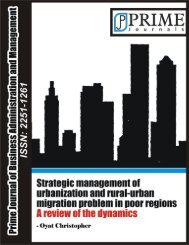Full Article (PDF) - prime journals limited
Full Article (PDF) - prime journals limited
Full Article (PDF) - prime journals limited
- No tags were found...
Create successful ePaper yourself
Turn your PDF publications into a flip-book with our unique Google optimized e-Paper software.
3 P J Engine. Tech. Res.the largest tiin the data set. ijis the coefficient arisingfrom the numerical scheme used to approximate theintegral in equation (10). For Simpson’s 1 3 rule, usedthroughout this investigation, 2 3 for odd j(except 1 i13), and 4 3The deviation ofCc from for even j.ijijMc is given byt'j tiMicic0 tir0ij( tit'j) fjt'(13)t'j 0 cMi C ciWhereCi1and itit'j ti0 Bir0 Aijfj , (14)t'0jB and, (15)Aij ij( tit'j) t'for ti t'j0 t t', (16) for i jt , i 1,2,3 ......, are the times at which theiN Dconcentration is measured andare the uniformly spaced discretized timet ' , j 1,2,3 ......, Nj0 t' t .In matrix notation equation (14) can be rewritten asM c Cc 0Br Af (17)Where,0t'j tit'0maxA ( t t') t'(18)jijC and B are ND1column vectors,A is a N N matrix of coefficient of the unknownDcolumn vector f f , f ,....., TiKf1, 2 3f NK. Since NKjKND, A isgenerally exceeds the number of data pointsnot a square matrix and equation (14) cannot be invertedto give a unique f , c0and r0. Instead, these unknownsare selected to minimize the sum of squares of i,N D2 T Mi c i1McCc 0Br0Cc0 Af Br0 Af T. (19)However, because of the noise in the experimental data, Tminimizing will not in general result in asmooth f (t). Hence, to ensure smoothness, additionalconditions have to be imposed, which is the minimizationof the sum of squares of the second derivatived2fdt'2at the internal discretization points. In terms ofthe column vector f , this condition takes on the form ofminimizingNk 1j22 d f dt2 2jTT Tf f f f, (20)Where is the tri-diagonal matrix of coefficients arisingfrom the finite difference approximation ofd2f1dt'2(Yeow et al., 2003) and is given by 211 2 1 1 2 1 1 . . . . . . . (21)t' 2. . . . . . . 1 2 1 1 2 1 TIKHONOV REGULARIZATIONIn Tikhonov regularization (Engl et al., 2000) instead of T and fT T fminimizingseparately, a linearcombination of these two quantitiesT T TR f fis minimized. is anadjustable weighting/regularization factor that controls theextent to which the noise in the kinetic data is beingfiltered out. Minimizing R requires the followingconditions to hold:Rfj 0R 0c0R 0r0j 1,2,3 ......, N , (22),K, (23), (24)These give rise to a set of linear algebraic equations forf , c0and r0(assuming that both initial conditions areknown). It can be shown (Shaw and Tigg, 1994) that thef , c0and r0that satisfy equations (22) to (24) are givenby:f ' TT 1 T MA'A' ' ' A'c (25)
Omowunmi and Susu 4where f ' denotes the column vectorf T1, f2,f3,.....,fN, c rK 0,0 incorporating c0and r0into f . A ' is the composite matrix A , C,Bderivedfrom equations (15), (16) and (18) to reflect the inclusionof c0and r0in f ' . Similarly, ' is the compositematrix ,0,0, where 0 is a N K 21column vectorof 0 to allow for the fact that c0and r0play no part in thesmoothness condition in equation (20) (Yeow et al.,2003). Equation (25) is the operating equation ofTikhonov regularization computation.IMPLEMENTATION OF THE COMPUTATIONAL STEPSThe implementation of this procedure based on Tikhonovregularization involves the generation of large matricesand thus requires the use of computer programmes orsuitable commercial software. In the present investigationFORTRAN programmes were used to generate thematrices arising from Tikhonov regularization andMATLAB was used to perform the matrix operations.Given any experimental time-concentration data, thefirst step is to divide the independent variable0 t' t into uniformly spaced discretization pointsKmaxN with step size t' tmax ( N 1)K. Then, matrixA ( ) is determined from equations (16) and (18)Aijand combined with the column matrices B and C to givethe composite matrix A ' in equation (25). Similarly, thecomposite matrix ' is obtained by combining matrix ,Kr and c C (t)given by equation (21), with the column vector 0 . In orderto simplify these computations, FORTRAN programmeswere developed to generate matrices A ' and directlyfrom the experimental data. The experimental timeconcentrationdata were inputs for these programmesand the outputs were matrices A ' and . Thesematrices are usually large in size depending on thevalues of NDand NK. In the present investigation, NDis in the range of 4 to 10 and NKis 21. However, largervalues of N are desirable in order to obtain wellbehavedsmooth functions for (t), but thiswill be at the expense of simplicity.The next step is the solution of equation (25) for valuesof f ' by simple matrix operations using MATLAB or anyother commercial software. These values of f ' are thensubstituted into the governing equation (10) to give theconcentrations c C (t)and also into the equation (2.8) tothe give the reaction rate r (t). Since f (t)is known at alarge number of closely spaced discretization points theintegration for r (t)and c C (t)is carried out numericallyto give well-behaved smooth functions. FORTRANprogrammes were generated from Simpson’s algorithmfor performing this task. The values of f ' were inputs forthese programmes and r (t)and c C (t)were the outputs.These computational steps are summarized in the Figure1.CHOICE OF REGULARIZATION PARAMETER The regularization parameter is an adjustableweighting/regularization factor that controls the extent towhich the noise in the kinetic data is being filtered out. Itbalances the two requirements o f (t): fitting the experimentaldata and remaining as smooth as possible.A large will give a smooth f (t)but at the expenseof the goodness of fit of the kinetic data and vice versa.The most appropriate value of depends on factorssuch as: the noise level in the experimental data, thenumber of data points ND, the number of discretizationpoints N and the numerical schemes used toKapproximate the integral in equation (10) and the secondderivative in equation (20). is neither a property of the reaction under considerationnor a constant determined by the concentrationmeasurement technique or instrument employed. (Yeowet al., 2003).A suitable choice of the regularization parameter hasto be provided by the user in order to apply Tikhonovregularization. In the present investigation, this choicehas been guided by the simple expectation that theCMaverage and maximum deviation between c and cmust be physically realistic i.e. they must be comparablewith the estimated magnitude of the error bars of thekinetic data while ensuring that the resulting reaction ratecurve is sufficiently smooth (Yeow et al., 2003). This isreferred to as the Morozov Principle in somemathematical texts (Engl et al., 2000). This principle wasapplied throughout this investigation for locating theappropriate . The value of that gave the minimumdeviation betweenCc andMc was chosen. It was alsoobserved that as long as is of the appropriate order ofmagnitude, changes of within this range do not greatlyaffect the final results. There are alternative methods forselecting such as the practical L-curve method(Hansen, 1992) or the statistically rigorous method ofGeneralized Cross Validation (Wahba, 1990).PARAMETER ESTIMATION AND OPTIMIZATIONTECHNIQUEEstimating the kinetic parameters of a rate model is avery important aspect of kinetics investigation due to thephysical significance of these parameters. This can beaccomplished by least-square fitting of the rate equation
5 P J Engine. Tech. Res.Experimental time-conversion(or time-concentration) dataDivide the independent variable 0≤ t' ≤ t maxinto uniformly spaced discretization points N kwith step size ∆t' = t max /(N k -1)Compute matrix A'by computer programCompute matrix βby computer programSolve for f' in the equationf' = (A' T A'+λβ' T β') -1 A' T C Musing MATLABCompute the concentrations C C (t)by computer programCompute the rates r(t)by computer programFigure 1: Schematic diagram for Tikhonov regularization solution technique.into the concentration-reaction rate curve. Severalnumerical minimization techniques have been developedto perform this task, these include: simulated annealing,random search, Nelder-Mead simplex method anddifferentiation evolution (Press et al., 1992). All theseminimization computations entail the assumption of initialguesses and can be performed using the commercialsoftware Mathematical.The general objective in optimization is to choose a setof values of variables (or parameters) subject to thevarious constraints that produce the desired optimumresponse for the chosen objective function (Edgar et al.,2001). The objective function in this case is the sum ofsquares of residuals between experimental andpredicted rates of reaction.n 2calc obsr i riS (26)i1The smaller the value of S , the better the model fits thedata and the more reliable the values of the kineticparameters thus obtained. The method used in thepresent investigation is called the flexible tolerancemethod (Paviani and Himmelblau, 1969) whichincorporates portions of the polyhedron method with theadditional advantage of not restricting intermediateiteration to the feasible region. The method used here isthe unweighted least square method (Aoki, 1971) which
RATE (ml/mg.min)7 P J Engine. Tech. Res.-0.020.06 0.08 0.1 0.12 0.14-0.02-0.02-0.02-0.02CONC. (gmol/m3)Figure 3: Concentration-reaction rate profile for n-heptane reforming on platinum/alumina catalyst at 460 o C.concentrations. Figure 3 shows the plot for theconcentration-rate profile obtained by Tikhonovregularization computation. This profile was used toobtain the rate and equilibrium constants in the ratemodels by the flexible tolerance search method. Usingthe stated selection criteria, the best trend of kineticparameters was observed for Model VI in agreement withthe findings above.2-HEPTENE REFORMING ON PLATINUM/ALUMINACATALYSTIn a similar investigation carried out by Susu andAkinfenwa (2004, unpublished) to study the kinetics ofthe reforming of 2-heptene on platinum/alumina catalyst,six rate equations were also proposed based on twopossible rate determining steps and three assumptions ofhydrogen adsorption. The experimental data were2reported at a total pressure of 4.0 kg cm andtemperature range of 420-500 o C (the experimental dataare contained in Appendix B). The reaction rates wereobtained by differentiation and the kinetic parameterswere estimated by the flexible tolerance search methodof Paviani and Himmelblau (1969). Based on theselection criteria, Model IV was reported as the best ofthe six models. This model is based on the assumptionthat hydrogen was adsorbed on the catalyst surface asbimolecular species. It is given by equation (3.2) with Qrepresenting 2-heptene.RIV1K C1QCTk4fK1K3CQCH K2 4rK9CBC K2CH K2 1K2K3CQCH 2K K7CP8CKT9CKM11(28)Tikhonov regularization computation was applied to theexperimental data to generate concentration-reaction ratedata. The concentration vs. W F plot for T 440 0 C isreproduced in Figure 4 while the concentration-reactionrate curve for T 440 0 C is shown in Figure 5. Using thisconcentration-reaction rate profile, the rate andequilibrium constants were determined by the flexibletolerance search technique. Contrary to the findingsabove, the kinetic parameters for Model V exhibitedtrends that agreed best with the selection criteria. Thismodel is based on the assumption that hydrogen wasadsorbed on catalyst surface as mono-molecular species.The expression for Model V is given in equation (29).RV3 f1212H12 1 CBCCPCM K1CQ K2CH1 K1K3K4CQ K1K3CQ kK K C CQ k3rCTK K49K7K8K112(29)3-Methylhexane Reforming on Platinum/AluminaCatalystThe kinetics of the reforming of 3-methylhexane on
RATE (ml/mg.min)CONC. (gmol/m3)Omowunmi and Susu 80.50.40.30.20.1Experimental values Poly. (Computed )00 1 2 3 4W/F (mg.min/ml)Figure 4: A plot of concentration vs. W/F for 2-heptene reforming on platinum/alumina catalyst at 440 o C.-0.100.1 0.15 0.2 0.25 0.3 0.35 0.4-0.10-0.11-0.11-0.11-0.11CONC. (gmol/m3)Figure 5: Concentration-reaction rate profile for 2-heptene reforming on platinum/alumina catalyst at 440 o C.
RATE (ml/mg.min)9 P J Engine. Tech. Res.-0.410 1 2 3 4 5 6-0.42-0.42-0.43-0.43-0.44CONC. (gmol/m3Figure 6: Concentration-reaction rate profile for 3-methylhepxane reforming on platinum/alumina catalyst at 440 o C.platinum-alumina catalyst was investigated by Susu andAmao (2002, unpublished). They proposed six ratemodels based on two possible rate-determining stepsand three different assumptions of hydrogen adsorptionon catalyst surface. The experimental data were reported2at a total pressure of 4.0 kg cm and temperature rangeof 420-500 o C (the experimental data are contained inAppendix C). The concentration-reaction rate profile wasobtained by differentiation and the rate equations werefitted into this profile by the flexible tolerance searchmethod to determine the rate and equilibrium constants.Based on the selection criteria, Model I was reported asthe model that fits the data best. The activation energiesobtained from the Arrhenius plot were negligible for boththe forward and backward reactions. The rate expressionfor this model is given byRI1K C1MHk3 fCK1K2CK2K1CH23MHH 2KC2H 2C k3rK1K2K3C CHC2 T K5K9MHH 2CKT9CKB11CKwhere MH represents 3-methylhexane, whileCP10(30)k 3 fk 3 rare the rate constants for the forward and backwardandreactions respectively.By applying Tikhonov regularization to the experimentaldata from this work, concentrations and reaction rateswere computed and used to estimate the rate andequilibrium constants in the rate models by the flexibletolerance search method. The concentration-reaction ratecurve for T 420 0 C is shown in Figure 6. The results ofthis investigation also confirmed Model I as the modelthat fits the data best based on the behavior of the rateand equilibrium constants.RESULTSThe kinetic parameters and the objective functionsobtained by fitting the selected rate models given byequations (27), (28) and (29) into the concentration-ratecurve generated by Tikhonov regularization are given inTables 1 to 3. The objective functions accompanyingthese results are also provided in these tables. In Table1, the equilibrium constants, K’s, and the rate constantsof the rate determining step, k’s, for the reforming of n-heptane on Pt/Al 2 O 3 , are depicted. Generally, the equilibriumconstants are expected to decrease with increasingtemperature while the rate constants are expected toincrease with increasing temperature. The ratio of therate constants for the forward and backward reactions ofthe rate determining step pronounces on the reversibilityand irreversibility of that step. Here, the ratio is about 3
Omowunmi and Susu 10Table 1: Kinetic parameters and objective functions for n-heptane (model VI)TEMPERATURE ( O C)420 440 460 480 500K11.192 1.318 1.270 1.757 1.757K285.780 85.740 85.840 85.700 85.700KKK3567.560 67.520 67.600 67.480 67.48056.870 56.830 56.810 56.810 56.8101053.540 53.480 53.660 53.430 53.430K1185.810 85.750 85.960 85.700 85.700K1256.920 56.860 57.100 56.810 56.810K1415.470 15.390 15.840 15.330 15.330k 4 f13.250 13.760 13.630 13.740 13.740k 4 r5.000 4.991 4.755 4.990 4.990OBJ. F. 0.0228 0.2044 0.0026 0.2646 0.0401Table 2. Kinetic parameters and objective functions for 2-heptene (model V)TEMPERATURE ( O C)420 440 460 480 500K177.720 78.990 78.580 95.520 99.970K246.360 47.780 47.290 28.940 20.880K349.460 49.530 48.890 52.790 60.170K428.190 28.290 27.280 0.015 0.089KK740.960 41.140 40.250 55.480 109.700843.970 44.130 43.400 66.780 63.450K1145.890 45.690 45.320 57.690 62.090k 3 f42.200 43.550 42.180 97.660 102.800k 3 r0.205 2.521 1.041 86.690 70.920OBJ. F. 0.007164 0.06023 0.04269 0.0000092347 0.0000054138for all the temperatures investigated, indicating that rateof the forward step is thrice that of the backward step.Table 2 shows the results for the kinetic parameters for2-heptene. The ratio of the rate constants fluctuate withvalues as high as 206 at the lowest temperature (420 o C),and a value as high as 42 at 460 o C. The ratios at the twohighest temperatures were about unity (1.12 and 1.44).Thus, at the lower temperatures, the reactions of the ratedetermining step are irreversible while at the highesttemperatures, they become reversible.Table 3 shows the kinetic parameters for 3-methylhexane.The ratio of the forward and backward rateconstants of the rate determining step varied between 5and 10, indicating that the forward reaction rate ismoderately irreversible.DISCUSSIONTikhonov regularization computation has been appliedsuccessfully to convert experimental time-concentrationdata into concentration-reaction rate data for n-heptane,2-heptene and 3-methylhexane reforming on Pt/Al 2 O 3catalyst. This technique has the advantage of keepingnoise amplification of the original data under control, asshown by the relatively smooth curves traced out by theconcentration-reaction rate profiles in Figures 3, 5 and 6.
11 P J Engine. Tech. Res.Table 3: Kinetic parameters and objective functions for 3-methylhexane (model I)TEMPERATURE ( O C)420 440 460 480 500K111.270 20.660 26.440 11.590 9.418K223.100 29.340 29.410 23.480 25.510KKKK3597.290 8.306 10.890 7.882 11.0702.029 11.070 2.549 2.689 2.5604.046 11.970 5.743 4.598 4.865103.956 7.955 4.313 4.489 5.172K116.117 9.218 5.396 6.677 7.158k 3 f6.540 10.980 32.280 7.493 50.000k 3 r1.380 1.868 3.551 1.443 5.072OBJ. F. 0.000097980 0.00008066 0.00006945 0.000042782 0.00014039Smoothness of these curves was achieved by choosingthe most appropriate value of the regularizationparameter . The computed concentration-reaction ratedata were used to determine the rate and equilibriumconstants in the rate models by the flexible tolerancesearch method. Based on the behavior of these parameters,the rate models were screened in order todetermine the model that fits the data best.In the analyses carried out on n-heptane, 2-hepteneand 3-methylheptane reforming, the similarity betweenthe experimental data and the concentration vs. W Fdata reproduced by Tikhonov regularization (Figures 2and 4)) can be considered as satisfactory, in view of theentirely different approach by which they were obtained.The verification of Model VI ( for n-heptane ) and Model I(for 3-methylheptane) by the present investigation as themodels of best fits, in agreement with the findings in thereferenced literatures, further establishes the reliability ofthis new technique. However, In the case of 2-heptene,Model V was selected as the best instead of Model IVreported in literature. It is observed, here, that theobjective functions obtained for Model V in this investigationwere generally smaller than those obtained for ModelIV in the referenced literature. This, therefore, suggeststhat Model V gives a better fit than Model IV since thesame search technique was applied in both cases. Asmentioned earlier, the models were screened based onthe conditions that the equilibrium constants must decreasewith increasing temperature while the rate constants mustincrease with increasing temperature. The plots ofequilibrium constants vs. temperature for the selectedmodels (models VI, V and I) are shown in Figures 7 to 9,while the plots of rate constants vs. temperature areshown in Figures 10 to 12.The Arrhenius plots for these three cases are given inFigures 13 to 15. For n-heptane reforming, the activationenergies obtained for the forward and backward reactionswere negligible. This suggests that the rate constants arerelatively insensitive to temperature changes, whichagrees with the relatively small values obtained in thereferenced literature (27 and 39 ). For the otherkJ molcases, the rate constants were more sensitive to temperaturechanges and the activation energies obtained forthe forward and backward reactions were 57.09 and233.35 kJ mol for 2-heptene, and 82.10 and52.09 kJ mol for 3-methylheptane respectively.CONCLUSIONThis paper has shown that Tikhonov regularizationtechnique, for converting experimental time-concentrationdata into concentration-reaction rate data, is applicable toa wide variety of hydrocarbon reactions. The resultsobtained by Tikhonov regularization were generally inagreement with the referenced literature, except in thecase of 2-heptene, where Model V was selected as thebest instead of Model IV. The kinetic parametersobtained by Tikhonov regularization were more reliableas indicated by the smaller objective functions obtained.Therefore, Tikhonov regularization technique is a reliableprocedure for converting experimental time-concentrationdata into concentration-reaction rate data. It does notrequire the assumption of a rate model to describe theexperimental data and it also manages to keep noiseamplification under control. Thus, it leads to a morereliable concentration-reaction rate profile and allows thekinetic parameters in the rate models to be determinedwith greater ease and also with a higher degree ofcertainty. The activation energies of the forward andbackward reactions of the rate determining step werenegligible for n-heptane, 57.69 and 233.35 kJ/mol for 2-heptane and 82.10 and 52.09 kJ/mol for 3-methyhexane.
EQUILIBRIUM CONSTANTS K (dimensionless)EQUILIBRIUM CONSTANTS K (dimensionless)Omowunmi and Susu 12100.080.060.040.020.00.0400 420 440 460 480 500 520TEMPERATURE T ( o C)K1 K2 K3 K5 K10 K12 K14Figure7: Equilibrium constants vs. Temperature for n-heptane reforming on platinum/alumina catalyst (model VI).120.0100.080.060.040.020.00.0400 420 440 460 480 500 520TEMPERATURE T ( o C)K1 K2 K3 K4 K7 K8 K11Figure 8: Equilibrium constants vs. Temperature for 2-heptene reforming on platinum/alumina catalyst (model V).
RATE CONSTANT kEQUILIBRIUM CONSTANTS K (dimensionless)13 P J Engine. Tech. Res.32.024.016.08.00.0400 420 440 460 480 500 520TEMPERATURE T ( o C)K1 K2 K3 K5 K9 K10 K11Figure 9: Equilibrium constants vs. Temperature for 3-Methylheptane reforming on platinum/alumina catalyst(model I).15.012.510.07.55.02.50.0400 420 440 460 480 500 520TEMPERATURE T ( o C)k4fk4rFigure 10: Rate constants vs. Temperature for n-heptane reforming on platinum/alumina catalyst (model VI).
RATE CONSTANTS kRATE CONSANTS kOmowunmi and Susu 14125.0100.075.050.025.00.0400 420 440 460 480 500 520TEMPERATURE T ( o C)k3fk3rFigure11: Rate constants vs. Temperature for 2-heptene reforming on platinum/alumina catalyst (model V).60.048.036.024.012.00.0400 420 440 460 480 500 520TEMPERATURE T(oC )k3fk3rFigure12: Rate constants vs. Temperature for 3-Methylheptane reforming on platinum/alumina catalyst (model I).
lnklnk15 P J Engine. Tech. Res.32.521.510.501.25 1.30 1.35 1.40 1.45 1.5010 3 /T(K)lnk4flnk4rFigure13: Arrhenius plot for n-heptane reforming on platinum/alumina catalyst (model VI).5.64.843.22.41.60.801.28 1.32 1.36 1.40 1.44 1.4810 3 /T (K)k3fk3rFigure 14: Arrhenius plot for 2-heptene reforming on platinum/alumina catalyst (model V).
lnkOmowunmi and Susu 164.843.22.41.60.801.28 1.32 1.36 1.40 1.44 1.4810 3 /T(K)lnk3flnk3rFigure15: Arrhenius plot for 3-Methylheptane reforming on platinum/alumina catalyst (model I).REFERENCESAberuagba F, Susu AA (1999). Nitrogen Influence onAromatic Selectivity during n-Heptane Reforming onFresh and Deactivating Platinum/Alumina and Platinum-Rhenium/Alumina Catalysts, Chem. Eng. Proc. 38: 179-196.Aberuagba F (1995). PhD Thesis, Chemical EngineeringDepartment, University of Lagos, Lagos, Nigeria.Aoki M (1971). Introduction to Optimization Techniques.New York: Macmillan.Edgar TF, Himmelblau DM, Lasdon LS (2001).Optimization of Chemical Processes (2nd ed.).Singapore: Mc Graw Hill.Engl HW, Hanke M, Neubauer A (2000). Regularizationof Inverse Problems. Dordrecht: Kluwer AcademicPublishers.Hansen PC (1992). Analysis of Discrete Ill-PosedProblems by Means of the L-curve. SIAM Rev. 34: 561-580.Nair MT, Sengupta TK (1997). Unsteady Flow PastElliptic Cylinders. J. Fluids Structures, 11: 555-595.Paviani DA, Himmelblau DM (1969). ConstrainedNonlinear Optimization by Heuristic Programmng.Operations Res. 17: 872-882.Press WH, Teukolsky SA, Vetterling WT, Flannery BP(1992). Numerical Recipes (2nd ed.). Cambridge:Cambridge University Press.Susu AA (1997). Chemical Kinetics and HeterogeneousCatalysis. Lagos: CJC Press (Nigeria) Ltd.Susu AA, Adenusi AM (1999). Model Discrimination ofNormal Heptane Reforming on Platinum/AluminaCatalyst, J. Nig. Soc. Chem. Engin. 16: 1-16.Susu AA, Akinfenwa AO (2004). Unpublished.Susu AA, Amao AM (2002). Unpublished.Wahba G (1990). Spline Models for observational Data.Philadelphia, PA: SIAM.Yeow YL, Taylor JW (2002). Obtaining the Shear Profileof Steady Laminar Flow of Newtonian and Non-Newtonian Fluids from Nuclear Magnetic ResonanceImaging and Laser Doppler Velocimetry Data, J. Rheol.46: 351-355.Yeow YL, Wickramasinghe SR, Binbing H, Leong Y(2003). A New Method of Processing the Time-Concentration Data of Reaction Kinetics. Chem. Eng.Sci. 58: 3601-3610.
17 P J Engine. Tech. Res.Appendix B. Experimental data of mole fraction of products in the exit stream for 2-heptenereforming on pt/al 2o 3 catalystTemperature ( o C) W/F C6H6 2-Heptene C7H8 Cracked Products4204404604805001.251.501.882.503.751.251.501.882.503.751.251.501.882.503.751.251.501.882.503.751.251.501.882.503.750.690.640.660.670.650.600.580.600.590.590.550.480.500.490.460.450.370.380.290.260.230.130.100.060.00.030.050.040.040.040.050.070.050.060.090.060.090.080.090.100080.140.110.110.120.110.200.120.120.130.140.160.160.150.160.180.180.180.180.190.190.210.210.220.220.240.250.260.300.420.480.370.440.480.490.150.140.150.140.150.170.170.170.170.170.190.220.210.200.220.230.240.250.300.300.280.300.340.360.38APPENDIX A. Experimental data of mole fraction of products in the exit stream for n-heptane reforming on pt/al 2o 3 catalystTemperature ( o C) W/F N-Hep C7H8 C6H6 Cracked Products0.831.250.690.650.160.180.00.00.150.174201.50 0.63 0.19 0.00.181.88 0.60 0.19 0.00.212.503.750.540.480.200.230.00.00.260.294404604805000.831.251.501.882.503.750.831.251.501.882.503.751.251.501.882.503.751.251.501.882.503.750.580.450.430.410.400.350.220.180.170.150.140.110.00.00.00.00.00.040.00.00.00.00.200.240.260.270.260.310.300.400.410.410.410.430.440.500.510.500.510.470.470.480.480.470.00.00.00.00.00.00.020.020.020.020.020.030.040.050.060.050.00.050.060.060.060.060.220.300.310.320.340.340.380.400.400.420.420.430.420.450.450.450.450.440.470.470.470.47
Omowunmi and Susu 18APPENDIX C. Experimental data of mole fraction of products in the exit stream for 3-methylhexanereforming on pt/al 2o 3 catalystTemperature ( o C) W/F 2-MH C7H8 C6H6 Cracked Products4201.251.501.882.503.751.00.980.960.940.850.00.00.00.00.040.00.010.020.020.050.00.010.020.040.064404604805001.251.501.882.503.751.251.501.882.503.751.251.501.882.503.751.251.501.882.503.750.970.950.930.910.780.930.920.900.850.670.920.890.830.760.630.900.830.750.650.390.00.00.00.020.050.00.00.00.030.060.00.00.00.040.060.00.030.050.050.090.020.030.040.020.090.050.050.050.060.120.060.060.090.100.130.060.090.100.150.220.010.020.030.040.080.020.030.050.060.150.020.050.080.100.180.040.050.100.150.30





![See Full Article [pdf] - prime journals limited](https://img.yumpu.com/49292987/1/190x245/see-full-article-pdf-prime-journals-limited.jpg?quality=85)



![See Full Article [pdf] - Prime Journals](https://img.yumpu.com/44526114/1/190x245/see-full-article-pdf-prime-journals.jpg?quality=85)

![See Full Article [pdf] - prime journals limited](https://img.yumpu.com/42270022/1/190x245/see-full-article-pdf-prime-journals-limited.jpg?quality=85)

![See Full Article [pdf] - Prime Journals](https://img.yumpu.com/41607332/1/190x245/see-full-article-pdf-prime-journals.jpg?quality=85)
![See Full Article [pdf] - Prime Journals](https://img.yumpu.com/41231982/1/190x245/see-full-article-pdf-prime-journals.jpg?quality=85)

